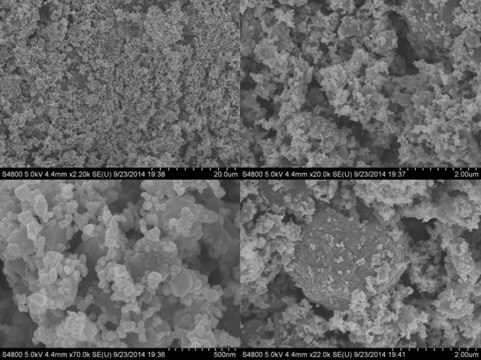725137
Lithium manganese dioxide
powder, <1 μm particle size, ≥98% trace metals basis
About This Item
Productos recomendados
grado
battery grade
Nivel de calidad
Análisis
≥98% trace metals basis
formulario
powder
mol peso
Mw 93.88 g/mol
composición
LiMnO2
características de los productos alternativos más sostenibles
Design for Energy Efficiency
Learn more about the Principles of Green Chemistry.
sustainability
Greener Alternative Product
tamaño de partícula
<1 μm
mp
400 °C
densidad
4.1 g/cm3 (lit.)
aplicaciones
battery manufacturing
categoría alternativa más sostenible
cadena SMILES
[Li+].O=[Mn-]=O
InChI
1S/Li.Mn.2O/q+1;-1;;
Clave InChI
HSDMUHSXXGFNMK-UHFFFAOYSA-N
Categorías relacionadas
Descripción general
Aplicación
- Safety of a continuous glucose monitoring device during hyperbaric exposure.: This study examines the safety and performance of a continuous glucose monitoring device under hyperbaric conditions, highlighting the reliability and durability of Lithium manganese dioxide batteries in medical applications (Bliss et al., 2020).
- The 6 volt battery for implantable cardioverter/defibrillators.: This paper discusses the use of Lithium manganese dioxide batteries in implantable cardioverter/defibrillators, emphasizing their high energy density and long life, making them ideal for critical medical devices (Drews et al., 1998).
Características y beneficios
Li-Batteries, material for electrodes design and manufacturing
Producto relacionado
Código de clase de almacenamiento
11 - Combustible Solids
Clase de riesgo para el agua (WGK)
WGK 3
Punto de inflamabilidad (°F)
Not applicable
Punto de inflamabilidad (°C)
Not applicable
Elija entre una de las versiones más recientes:
¿Ya tiene este producto?
Encuentre la documentación para los productos que ha comprado recientemente en la Biblioteca de documentos.
Los clientes también vieron
Artículos
Nanomaterials for Energy Storage in Lithium-ion Battery Applications
Increasing fuel costs and concerns about greenhouse gas emissions have spurred the growth in sales of hybrid electric vehicles (HEVs) that carry a battery pack to supplement the performance of the internal combustion engine (ICE).
Professor Qiao’s laboratory lays out recent advances in conversion type lithium metal fluoride batteries. This review explores key concepts in developing electrochemically stable microstructures for wide Li-ion insertion channels.
Li-ion batteries are currently the focus of numerous research efforts with applications designed to reduce carbon-based emissions and improve energy storage capabilities.
Nuestro equipo de científicos tiene experiencia en todas las áreas de investigación: Ciencias de la vida, Ciencia de los materiales, Síntesis química, Cromatografía, Analítica y muchas otras.
Póngase en contacto con el Servicio técnico











